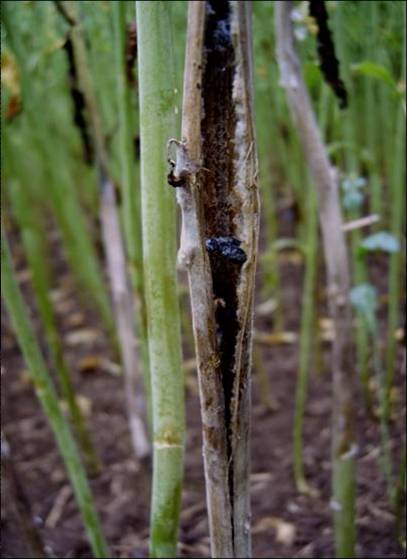
This service, available at www.totaloilseedcare.co.uk, starts on 20th March and runs for twelve weeks, ending on the 12th June.
High risk year expected
With two consecutive years of high Sclerotinia incidence, disease pressure is predicted to be high in many oilseed rape crops this year. But it is still important to monitor disease risk and decide on the need for, and timing of effective fungicide treatments such as Filan, Compass or Caramba .
Because fungicides used for Sclerotinia are protectant, their applications must be timed correctly, in advance of the disease. So it is important that disease risk is assessed and monitored.
Monitoring service
• ADAS and BASF have jointly developed a web-based germination monitoring service that has run for seven years now and this service has proved to be a useful management tool to assess disease risk and the need for treatment.
• It monitors the germination of the pathogens resting stage, the sclerotia, buried in fields of winter oilseed rape crops across the country.
• Germination assessments are made each week for 12 weeks, with results being updated every Friday. Each site will be supported by petal testing which help establish disease pressure from air-borne spores. This data is used in conjunction with the sclerotial germination test to accurately predict the risk of an epidemic.
Sclerotinia incidence
Last year in Defra-funded surveys of commercial crops 6.2% of plants were infected by Sclerotinia across the country and 5.7% were infected the year before. These were the worse years ever experienced for Sclerotinia.
Some crops had over 80% infection and some crops lost over 2.0 t/ha yield.
Few geographic areas escaped infection. Previously high disease levels were logged in certain parts of the UK, such as the South West and West Midlands. But last year there were serious infections in East Anglia, Lincolnshire and Yorkshire.
Last year many crops saw protracted spore release through an extended flowering of up to eight weeks which meant that disease pressure was exerted for longer, putting pressure on timing and persistence of fungicides treatments.
Sclerotinia risk this year
Sclerotia germination increases once the soil temperature has reached 10˚C provided the soil surface is moist. This year there has been no activity as yet, as the soil temperatures are still quite cold. But once temperatures start to rise then germination will start.
The sclerotia then release air-borne spores, which infect oilseed rape petals. Crops are at high risk if sclerotia germination is synchronised with early flowering.
With a lot of pigeon damaged, backward rape crops this year, it is likely that there will be another long flowering period which will exacerbate disease risk once again.
Extended flowering combined with high levels of sclerotia in the soil plus spores travelling over 100 metres from nearby fields adds up to high risk, even for virgin rape.
Sclerotinia can be responsible for substantial yield loss and needs to be monitored closely.
Managing the problem
BASF advises growers to plan a two-spray programme, especially where crops suffered last year, and to use fungicides with proven persistence and performance.
In independent trials Filan (boscalid) and Compass (thiophanate-methyl plus iprodione) gave excellent levels of control of Sclerotinia when applied at the correct time and at appropriate dose rates. They give reliable and consistent protection against Sclerotinia, as well as broad-spectrum activity against Alternaria and Botrytis. Where pest thresholds are reached, they can be tank-mixed with pyrethroid insecticides without any concerns on enhanced bee toxicity. They also offer an alternative mode of action into an overall disease programme that tends to be crowded with triazoles. Both Filan and Compass are protectants and so they need to get on before any significant petal fall.
ADAS are advising growers to use minimum three-quarter dose rate, to consider a 2 spray programme and to make sure that spray coverage is good.
If the GAI (Green Area Index) of the crop is 2 or more in April, then start with Caramba. This produces more uniform flowering across the main and side branches and, by strengthening the side branches, can help the plants ’lock’ together and so reduce late lodging.
Caramba is also an excellent first spray in the Sclerotinia programme, reflected by ADAS trials in 2008, allowing good coverage of the lower canopy and protection from any early petal fall. It can then be followed by Filan or Compass about 3 weeks later at the start of the main petal fall period.
For further information please contact Clare Tucker, BASF on 07768 687707 or by email at clare.tucker@basf.com
